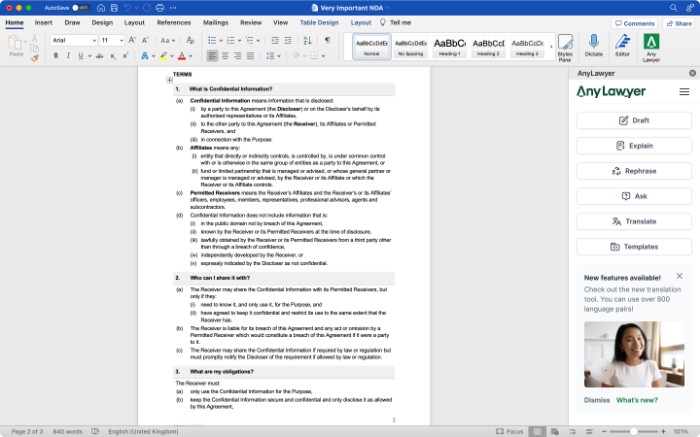Legal writing is often seen as a daunting task, as it involves constructing precise and complex documents like contracts in accordance with standard clauses. It is no wonder that many legal professionals are turning to AI-based tools like AnyLawyer to help with this time-consuming task. With their help, legal professionals and non-lawyers alike can get an edge in their document drafting process.
In this blog post, we will discuss the best editing software for legal writing as well as how to make the most out of these tools to achieve accurate results, a streamlined workflow, and maximum efficiency when drafting (or editing) contracts.
Legal writing - an introduction
Legal writing requires precision, clarity, and accuracy. It covers a range of areas including contracts, legal briefs, letters of intent, memorandum of understanding (MOUs), wills, and more. To ensure the best results in legal writing projects, one must familiarize themselves with the rules regulating each specific area as well as pay attention to syntax and formatting.
Common legal writing and editing errors
Some of the most common errors in legal writing are typos, incorrect grammar, misspelled terms, and omissions. It is not uncommon for a single typo to cause a major disruption in the document’s meaning and consequently affect its validity. To avoid any such issues, reliable editing and proofreading tools should be utilized.
Style guides for legal writing
Legal writing should also adhere to a specific style guide, usually set by the particular court or company. The American Bar Association (ABA) has developed a number of such style guides for legal professionals to refer to when drafting documents.
- The Bluebook: This is the most commonly used style guide in the US for legal writing. It covers citation rules and other requirements related to formatting documents, such as how to create footnotes, use parenthetical citations, or structure bibliographies.
- The Maroonbook: Developed by the Harvard Law Review and widely used at Harvard Law School, this style guide focuses on legal citations. It covers topics such as abbreviations, case names, and citing state or federal statutes.
- The ALWD Guide to Legal Citation: Developed by the Association of Legal Writing Directors (ALWD), this style guide offers guidance for legal document construction and formatting. It specifically outlines rules for citation practices related to court opinions, statutes, and journal articles.
Other countries have their own tyle guides, such as The Oxford University Standard for the Citation of Legal Authorities (OSCOLA) in the UK or The Australian Guide to Legal Citation (AGLC) in Australia.
Jurisdictions-based variants
Many jurisdictions have their own regulations and style guides when it comes to legal writing. The requirements for legal briefs, for example, vary from court to court. It is important for legal writers to be aware of these particularities in order to create legally sound documents.
Standard clauses in a contract
Standard clauses are established rules or terms that are typically included in most contracts. These clauses include such things as warranties, indemnities, and choice of law. It is important to understand the purpose and implications of each clause in order to ensure a contract’s validity. It is also important to be very conscious of any changes made to standard clauses, as they may have a significant impact on the contract’s overall legality.
The process of proofreading and editing legal writing
Ensuring that legal documents are free of errors, readable and clear is very time-consuming and challenging. The document may need to be read multiple times to ensure accuracy, which can often take hours or days, depending on the length, complexity and type of the document.
Legal documents are highly specialized, and require specific knowledge that is not always easy to acquire. This is why many legal professionals often rely on AI-based tools as an efficient solution for editing legal writing projects.
Such tools offer a suite of services, including:
- Intelligent word suggestion based on context,
- Sentence structure and grammar checks,
- Word choice analysis,
- Grammatical error detection,
- Syntax and style correction .
In addition, AI-based tools offer automated editing and proofreading features, customizable templates, searchable databases with verified sources, and instant feedback on errors.
Choosing the best software editing tool for legal writing
When deciding which tool to use, it is important to consider the level of accuracy and speed needed. Different tools offer different levels of precision and automation. It is also important to consider whether or not a tool offers features that are specific to legal writing, such as the ability to detect errors related to standard clauses in contracts, for example.
Top legal writing and editing software
1. Grammarly

This general use tool helps writers identify and fix grammar, spelling, and punctuation errors. It also offers contextual spell checkers, AI-driven writing suggestions to boost readability, and free features like plagiarism checkers.
2. AnyLawyer

A comprehensive AI-based solution for contract drafting and editing. It helps law firms and legal teams construct contracts quickly and accurately, with the use of automated document analysis technology, legal proofreading, contract clause explanations, and real-time fact checking to make sure each legal document is based on latest regulations.
3. Microsoft Word extensions
The go-to application for word processing needs, such as legal documents, and its advanced grammar and spell checkers can help writers quickly identify and fix typos.
4. PerfectIt

This application helps users to identify and fix typos, inconsistencies in punctuation, formatting errors, spelling mistakes, incorrect citations, and more. It can reduce time spent on proofreading by 90%. Programmed based on positions such as the Bluebook: A Uniform System of Citation, The Red Book: A Manual On Legal Style, and Black’s Law Dictionary, the American Legal Style integration for PerfectIt helps easily spot mistakes that are most often overlooked by human proofreaders.
5. WordRake

This advanced editing tool helps lawyers spot and correct unnecessary words, provide clarity to complex sentences, and improve language in legal documents. WordRake is integrated with Microsoft Office and works on both Macs and PCs.
6. Lightkey

This AI-based software can help lawyers with writing, editing, and formatting legal documents. It is integrated into Microsoft Office, Chrome and Edge. It offers text prediction and real-time correction, a vocabulary manager, as well as analytics for tracking productivity metrics. Lightkey uses advanced NLP technology to suggest edits based on context.
7. Hemingway

This application helps writers to edit their work for readability, e.g. by simplifying sentences that are flagged as too complicated. It also assists in spotting hard-to-find errors such as the incorrect use of homophones (words such as affect/effect and they’re/their). Hemingway works on Mac and Windows computers, and does not require an internet connection.
8. BriefCatch

This AI-powered legal writing tool helps lawyers to quickly identify and fix errors in their documents. It provides automated analysis of written work, with a focus on tone and readability. It relies on a trove of best practices, clearly explains its suggestions, and provides real world examples. BriefCatch is integrated into Microsoft Word and other popular applications for Macs & PCs, as well as web-based solutions.
9. Copyscape

This website helps writers to check for plagiarism and other copyright infringements. Spotted issues can be easily paraphrased or supplemented with citations. The tool's free version is a plagiarism checker that finds copies of web pages. Its paid plan includes PDF and Word file uploads, batch searching, and more.
10. Scrivener

This application helps writers to easily organize their work, create outlines and drafts, and compile all the pieces together into a finished document. It works on Windows, macOS and iOS.
How AI tools support legal document editing
AI-based tools like AnyLawyer are excellent at supplementing the legal writing skills of lawyers and other professionals at a law firm. They reduce writing time, correct spelling, match style and tone to the intended audience, and much more. They can also help people without legal careers to better understand business contracts and clauses, offer them an edge in disputes, or even solve less complex legal issues.
AI solutions are great for legal document editing, as they can quickly recognize common clauses and formatting requirements. This allows users to get accurate results in no time. AI-based tools can also detect nuances in legal writing, understand the meaning of words, and check for accuracy using natural language processing. This means that lawyers can trust that the documents they produce are accurate and error-free.
Making the most out of legal proofreading tools
To make the most out of these tools, it is important to adequately prepare your documents before using them. Here are some tips:
- Review the document for typos and grammar errors before submitting it to an editing tool.
- Structure your documents according to the purpose of each clause and make sure that there is a logical flow between them.
- Utilize standard legal terms when possible, as they are recognized by most editing tools.
Other resources
The Legal Writers Bureau
This online platform provides human proofreading/editing services, with a team of expert legal editors - journalists who have been responsible for articles in highly respected legal publications. They specialize in correcting grammar and spelling mistakes, as well as ensuring that the document follows correct legal formatting and style. They can handle all types of content, including blog articles and white papers.
LawProse
This online service offers writing, editing, and proofreading services for legal documents. Their team of editors consists of experienced attorneys who are well-versed in all areas of the law, making them ideal for enhancing legal accuracy and precision. They train their editors to spot common errors as well as complex issues that arise regarding the language used in legal documents.
One Look Reverse Dictionary
Reverse dictionaries can be useful for legal writers who are looking for the right words to express their ideas. One Look Reverse Dictionary provides a searchable database of words, organized by definition. It helps to quickly find the perfect word for a certain context.
How legal professionals can optimize the process of editing legal documents
Legal writing is both a big part of the legal profession and a complex task that requires precise wording and accuracy. Fortunately, reliable editing tools can be used to help with this task. From AI-based solutions to Microsoft Word extensions, there are a variety of options available for legal document editing and proofreading. By following the tips outlined here and properly preparing your documents before submitting them to an editing tool, you can make the most out of these tools and ensure accurate results with maximum efficiency.




